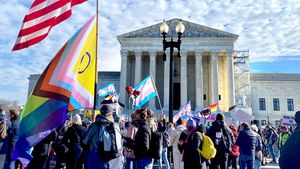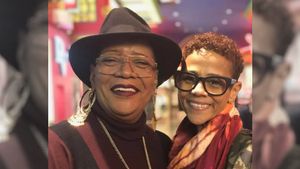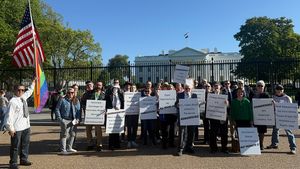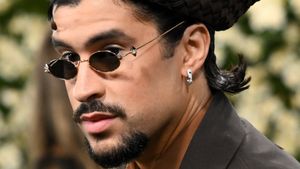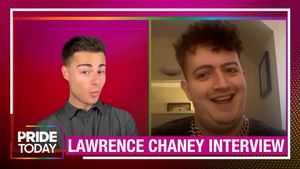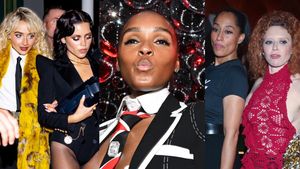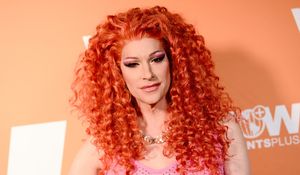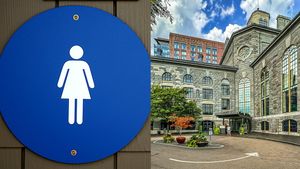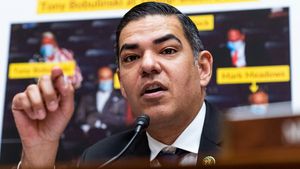The Connecticut Sun is gearing up for its next LGBTQ+ Pride night at the Mohegan Sun Arena on Friday night, and Layshia Clarendon is ready for it. The team's exuberant, gender nonconforming guard won't be on the court this time around -- she's nursing her ankle back to health after surgery, so she'll be rooting along from the sidelines. But this isn't Clarendon's first Pride night as a player.
As a queer kid, Clarendon found solace in basketball, both in the way she could express herself, and through other players. Six years into her WNBA career, Clarendon's not only a leader on her team, but a leader among players as a member of the Women's National Basketball Players Association, the union for the WNBA's players. On Thursday, Clarendon talked to Out about what it means for the WNBA to recognize players across a diverse spectrum and the thing that's on every queer woman's mind: how amazing Megan Rapinoe is.
Out: So to start, I'd love to know what Pride Night means to you as a member of the Connecticut Sun and more generally as a player in the WNBA?
Layshia Clarendon: It means a lot, to have the team celebrate LGBTQ people is a big deal, and we have to celebrate that -- it's really important. We've seen [Mohegan Sun's Vice President of Sports] Amber Cox really bump up the Sun's Pride night. It's hard to explain this feeling. It's like the people around you just want to celebrate you.
It's been five years into the WNBA's pivot toward more openly embracing its LGBTQ+ players and fans. What does it mean to have the support of the WNBA as an out player?
I think 5 years ago when we ... started directly marketing to the LGBT community was an important moment for the league -- finally acknowledging we have so many queer players and queer fans who have been there throughout the years, through the ups and downs. I think we've seen the shift starting to happen, where we're more accurately representing the players you have in this league. It's also a predominantly Black league, so it's not just with our sexuality and our queer identity, but we've seen the league embrace, holistically, the types of players we have. We have gay people, people of color, people with college degrees -- we have so many amazing, dynamic people in this league, and the WNBA has embraced who we are and celebrates it.
Ooh, could you say more about what you mean by the league being more supportive of Black women?
Our Make Way commercial that the WNBA made came out with this year. Even just looking at that commercial you see, the young girls, the players, and obviously they chose racial diverse players in our league. To me, that commercial was a sort of turning point in how it has really shown that it's embracing the different types of people in our league. When I first saw it, I was just like, "Yes, finally!" It shows players dressed in all different ways -- parts of the Make Way campaign involve people who just look like me, who are gender nonconforming. That's one of the only times I've seen people who look like me in ad campaigns like that. They're not just people who are perceived to be femme, perceived to be straight -- that's typically what we've done in marketing the league -- it's embracing what our league is.
Something I've heard you talk about before is how sports can be a safe space for so many LGBTQ+ people. Could you talk about that a little more? I think in some ways the conventional wisdom is that out people are not always welcome but I think the ways in which queer folks interact with sports is a little more nuanced than that.
I think you have to take it story by story, like any group. There's not one voice that can speak for the group, though oftentimes that happens with minorities. It's like, "OK, speak for the whole group!" and that's not fair. I do think sports can be a safe space for a lot of people. For me, it was a place where, gender identity-wise, I could get away with my boyish expression, I could wear boyish clothes. When I was younger, I wasn't out to my parents, and they wouldn't buy me boy jeans or boy clothes, or let me shop in the boy's section. But when it came with athletic wear, I could get away with wearing guys' sweats or basketball shorts. It helped me feel like I could at least be part of myself when I was growing up. And that helped me feel better, and it let me feel the way I wanted to feel.
I know you've been following the US Women's National Soccer Team. What have been some of the highlights for you, watching them play throughout the World Cup?
Megan Rapinoe has been giving the whole country life. Just seeing someone with short hair and dyes it pink, and just so authentically walks so comfortably in her own skin -- it's been refreshing to watch another athlete like that. And her activism, the way it's just blossomed -- everything from when she knelt for racial justice like Colin Kaepernick, and her fight for equal pay and equality -- it's a collective fight that we see around the country. This awakening and rise of the women's movement -- you know, of course there's the #MeToo movement, and access to sports and equal pay. It's been refreshing to watch Megan as one example of that.
As someone on the [Women's Basketball Player's Association], our fights are different in a lot of ways, in terms of structure of our leagues and teams, but we're all fighting for the same thing: better resources, better compensation and pay. We are the best in the world, but we're not treated like it.
RELATED | U.S. Women's National Team Takes Over New York in Parade








